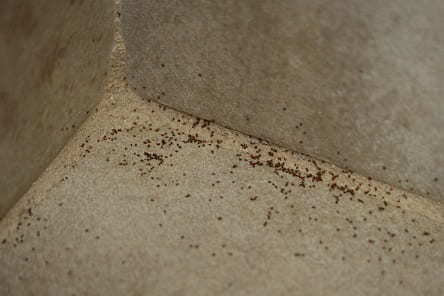–by Raymond Cloyd, Horticultural Entomology
We have received a number of inquiries regarding homes being invaded by populations of the clover mite, Bryobia praetiosa. Now is the time of year when clover mites enter homes, apartments, or commercial buildings, with extensive numbers crawling around and causing people to be somewhat concerned regarding how to deal with the problem.
Clover mites typically enter homes and buildings from a southwest exposure. Once inside, clover mites aggregate in large numbers in the corners of homes and buildings (Figure 1).

Figure 1. Clover mites aggregating in the corner of a building (Raymond Cloyd, KSU)
Clover mites are primarily a nuisance mite pest because they do not bite humans. However, clover mites will leave a red stain when purposely or accidently crushed.
Clover mite populations only consist of females as males have never been found. Adult clover mites are 1/30 of an inch long, red, with long, pink front legs (Figure 2)

Figure 2. Adult clover
that are used to distinguish clover mites from other mite pests. Clover mites overwinter as eggs in protected locations and there is usually one generation per year in Kansas. Adults feed on over 200 plant types including: clover, grasses, ivy, honeysuckle, apple, freesia, and elm. Clover mite populations can be extensive in well-fertilized turfgrass located near foundations and their feeding will cause turfgrass to appear silvery or frosty.
The management of clover mites involves the following:
1) Remove turfgrass near building foundations.
2) Place an 18 to 36-inch wide band of an inorganic mulch around the foundation of homes and buildings.
3) Mow turfgrass as short as possible.
4) Avoid over-fertilizing turfgrass, especially with water-soluble, nitrogen-based fertilizers.
5) Remove weeds growing around the foundation.
6) Remove or limit the growth of ivy or other host plants growing around the foundation or walls.
7) Use plants near the foundation that are not typically attractive to clover mites, including: marigold, petunia, geranium, arborvitae, and/or yew.
8) Caulk or seal cracks or openings in the foundation or around window seals.
Clover mites inside homes or building can be vacuumed up, however, be sure to avoid crushing them. Clover mites can be captured on sticky tape (Figure 3)

Figure 3. Clover mites captured on sticky tape (Raymond Cloyd, KSU)
placed near openings such as window seals. Pesticides that contain the active ingredient permethrin can be applied around the perimeter of homes or buildings to kill clover mites, which will reduce the number entering homes and buildings. However, do not apply pesticides inside homes or buildings. If necessary, consult with a pest management professional for recommendations regarding perimeter treatments of pesticides with miticidal activity that will prevent clover mites from entering homes or buildings.